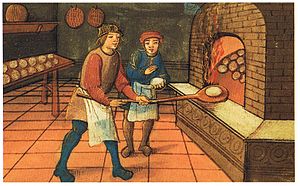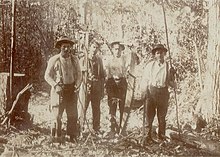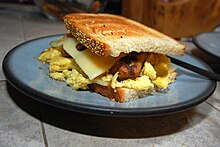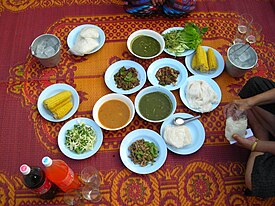History of breakfast
The examples and perspective in this article may not represent a worldwide view of the subject. (August 2020) |
| Part of a series on |
| Meals |
|---|
 |
| Meals |
|
| Components and courses |
|
| Related concepts |
|
Breakfast is a meal eaten in many countries around the globe at the beginning of the day. The tradition of eating a morning meal has existed since ancient times, though it was not until the 15th century that "breakfast" came into use in written English to describe it,[1]: 6 literally meaning "to break the fasting period of the prior night"; in Old English, the corresponding term was 'morgenmete', meaning "morning meal".[2]
Ancient breakfast[]
Ancient Egypt[]
In Ancient Egypt, peasants ate a daily meal, most likely in the morning, consisting of beer, bread, and onions before they left for work in the fields or work commanded by the pharaohs.[3]
The traditional breakfast believed to have been cooked in ancient Egypt was 'foul' (also known as 'fool'; rather than poultry, this referred to fava beans), , made from emmer wheat and falafel, and a mixture of fava beans with onions, garlic, parsley and coriander.[4]
Ancient Greece[]
In Greek literature, Homer makes numerous mentions of ariston, a meal taken not long after sunrise. The Iliad notes this meal with regard to a labor-weary woodsman eager for a light repast to start his day, preparing it even as he is aching with exhaustion.[5] The opening prose of the 16th book of The Odyssey mentions breakfast as the meal being prepared in the morning before attending to one's chores.[6] Eventually ariston was moved to around noon, and a new morning meal was introduced.
In the post-Homeric classical period of Greece, a meal called akratisma was typically consumed immediately after rising in the morning.[5] Akratisma (ἀκρατισμός, akratismos) consisted of barley bread dipped in wine (ἄκρατος, akratos), sometimes complemented by figs or olives.[7] They also made pancakes called tēganitēs (τηγανίτης), tagēnitēs (ταγηνίτης).[8] or tagēnias (ταγηνίας),[9] all words deriving from tagēnon (τάγηνον), meaning "frying pan".[10] The earliest attested references on tagēnias are in the works of the 5th century BC poets Cratinus[11] and Magnes.[12][13][14] Another kind of pancake was staititēs (σταιτίτης), from staitinos (σταίτινος), "of flour or dough of spelt",[15] derived itself from stais (σταῖς), "flour of spelt".[16] Athenaeus in his Deipnosophistae mentions staititas topped with honey, sesame and cheese.[17][18][19]
Ancient Rome[]
Romans called breakfast jentaculum (or ientaculum). It was usually composed of everyday staples like bread, cheese, olives, salad, nuts, raisins, and cold meat left over from the night before.[20] They also drank wine-based drinks such as mulsum, a mixture of wine, honey, and aromatic spices.[21] 1st century Latin poet Martial said that jentaculum as eaten at 3:00 or 4:00 in the morning, while 16th century scholar Claudius Saumaise wrote that it was typically eaten at 9:00 or 10:00 a.m. It seems unlikely that any fixed time was truly assigned for this meal.[22]
Roman soldiers woke up to a breakfast of pulmentus, porridge similar to the Italian polenta, made from roasted spelt wheat or barley that was then pounded and cooked in a cauldron of water.[23]
Middle Ages (500–1500)[]
Europe[]
This section's factual accuracy is disputed. (June 2021) |

In the European Middle Ages, breakfast was not usually considered a necessary and important meal, and was practically nonexistent during the earlier medieval period. Monarchs and their entourages would spend much time around a table for meals. Only two formal meals were eaten per day—one at mid-day and one in the evening. The exact times varied by period and region, but this two-meal system remained consistent throughout the Middle Ages.
Breakfast in some times and places was solely granted to children, the elderly, the sick, and to working men. Anyone else did not speak of or partake in eating in the morning. Eating breakfast meant that one was poor, was a low-status farmer or laborer who truly needed the energy to sustain his morning's labor, or was too weak to make it to the large, midday dinner.[24]
In the 13th century, breakfast when eaten sometimes consisted of a piece of rye bread and a bit of cheese. Morning meals would not include any meat, and would likely include 0.4 imperial gallons (1.8 l) of low alcohol-content beers. Uncertain quantities of bread and ale could have been consumed in between meals.[25]
By the 15th century, breakfast in western Europe often included meat.[1] By this time, noble men were seen to indulge in breakfast, making it more of a common practice, and by the early 16th century, recorded expenses for breakfast became customary. Breakfast in eastern Europe remained mostly the same as the modern day: a "continental breakfast". The 16th century introduction of caffeinated beverages into the European diet was also an addition to breakfast, believed that coffee and tea aid the body in "evacuation of superfluities".[1]
Modern breakfast (1500–present)[]
Africa[]
Traditionally, the various cuisines of Africa use a combination of locally available fruits, cereal grains and vegetables, as well as milk and meat products. In some parts of the continent, the traditional diet features milk, curd and whey products. A type of porridge is most commonly eaten. In the book The Bible cyclopædia (et al.) published in 1843, it was documented that during this time in the Arab world, Bedouins often utilized locusts mixed with butter for breakfast, spreading the mixture on unleavened bread.[26]
Egypt[]
In the book The Bible cyclopædia (et al.) published in 1843, it was documented that Egyptians were early risers that sometimes had a first meal consisting of coffee along with the smoking of a pipe, and did not eat breakfast until noon.[27] At this time, it was documented that Egyptian breakfast foods included bread, cheese, eggs, butter, curds, clotted cream and stewed beans.[27] In addition, fava beans are an established national breakfast dish.[28]
Asia[]
Middle East[]
In the Middle East region of Asia, Middle Eastern cuisine is popular.[citation needed] Iftar refers to the evening meal when Muslims break their sawm (fast) during the Islamic month of Ramadan. Iftar is one of the religious observances of Ramadan, and is often done as a community, with people gathering to break their fast together. Iftar is done right after Maghrib (sunset) time. During the month of Ramadan, Muslims replace traditional breakfast with suhoor, an Islamic term referring to the meal consumed early in the morning by Muslims before sawm during daylight hours. The meal is eaten before fajr (dawn).[29]
Israel[]
Japan[]
In Japan, it is common to eat miso soup and rice porridge for breakfast.[30]
Lebanon[]
In the book The Bible cyclopædia (et al.) it was documented that circa 1843, poor Lebanese people would consume raw leeks with bread for breakfast.[31]
Europe[]
Austria[]
The croissant appears to have originated in Vienna, Austria, in 1683.[32][33]
France[]
French breakfasts are often similar to what Americans call a continental breakfast.[34] French breakfast pastries include apple turnovers, brioche, croissant[35] and pain au chocolat.[36] Croissants have been described as becoming a standard fare in French breakfast cuisine by 1875.[35]
Netherlands[]
The word waffle derives from the Dutch word "wafel", which itself derives from the Middle Dutch wafele,[37] and is likely the origin of the food as it is known today.[38]

United Kingdom[]

In the early 16th century, some physicians warned against eating breakfast, because they said it was not healthy to eat before a prior meal was digested.[39] By the 1550s, however, there were multiple sources that claimed breakfast was an important meal. For example, in 1551, Thomas Wingfield stated that breakfast was essential. In 1589, Thomas Cogan stated that it was unhealthy to miss breakfast in the morning. He was one of the first to claim that it was healthy for those who were not young, ill or elders to eat breakfast.[40]
The full breakfast is a staple of British cuisine, and typically consists of bacon, sausages and eggs, often served with a variety of side dishes and a beverage such as coffee or tea. Prior to 1600, breakfast in Great Britain typically included bread, cold meat or fish, and ale.[41] Tea, chocolate and coffee were introduced to Great Britain in the mid-1600s, and in the 1700s coffee and chocolate were adopted as breakfast drinks by the fashionable.[41] Tea eventually became more popular than chocolate as a breakfast drink.[41]
North America[]
The first groups known to have produced maple syrup and maple sugar were indigenous peoples living in the northeastern part of North America. According to aboriginal oral traditions, as well as archaeological evidence, maple tree sap was being processed into syrup long before Europeans arrived in the region.[42][43]
Canada[]

While it has been a source of controversy where the lumberjack breakfast came from, the most cited source is that the lumberjack breakfast was first served in a Vancouver Hotel, in 1870. The breakfast consisted of eggs, assorted fried pork strips, and flapjacks. It is said by Anita Stewart that the tradition of hearty cooking developed because of men needing the energy for manual labor.[44]
United States[]
In 1620, waffles were first introduced to North America by pilgrims who had lived in the Netherlands.[45] Later pioneers consumed largely cornmeal-based breakfasts, and would also consume corn based meals such as oatmeal for dinner and lunch.[46] Common breakfast products included corn pone, johnnycakes, , hoe-cakes, and .[46] Ashcakes consisted of cornmeal wrapped in cabbage leaves cooked in the ashes of a campfire, while corn pone, corn dodgers, and hoe-cakes differed only in baking methods.[46][47] After the American Civil War, it became fairly common in America to eat sandwiches that were made of ham and eggs. These sandwiches were not strictly consumed in the morning. In 1897, the first true breakfast sandwich recipe was published in a cookbook.[48]

Popcorn cereal was consumed by Americans in the 1800s, which typically consisted of popcorn with milk and a sweetener.[49] Cold breakfast cereal has been consumed by Americans since the late 1890s, and during the 1920s a considerable number of new cereals were marketed.[50] The reason for this movement towards cold breakfast cereals was inspired by the Jacksonian-era Clean Living Movement (1830–1860). This movement focused on a lot of lifestyle changes, but specific to breakfast it claimed that eating bacon, eggs, pancakes and hot coffee was too indulgent.[51] The first prepared cold breakfast cereal marketed to American consumers was created by Dr. John Harvey Kellogg, who introduced it in 1878 and named it granola.[52] The product was prepared with baked wheat, oatmeal and cornmeal, and was the first brand-name breakfast cereal in the United States.[52]
Canned fruit juice became prominent as a breakfast beverage after the discovery of vitamins.[53] Circa 1900, orange juice as a breakfast beverage was a new concept.[52] The development of frozen orange juice concentrate began in 1915, and in the 1930s it was produced by several companies.[54] Additionally, mass-produced tomato juice began to be marketed in the mid-1920s, and became a popular breakfast drink a few years thereafter.[50]
See also[]
- Food history
- List of breakfast beverages
- List of breakfast foods
- List of food and beverage museums
- Timeline of food
References[]
- ^ Jump up to: a b c Anderson, Heather Arndt (2013). Breakfast: A History. AltaMira Press. ISBN 0759121656
- ^ "Breakfast". Etymonline.com. Retrieved February 2, 2013.
- ^ Alcock, Joan (2006). Food in the Ancient World. Westport, CT: Greenwood Press. p. 181. ISBN 0-313-33003-4.
- ^ Elnasharty, Tasnim (11 March 2020). "The Most Famous Traditional Egyptian Breakfast--Foul and Falafel". www.arabamerica.com. Retrieved 24 May 2021.
- ^ Jump up to: a b Anderson, pg 9
- ^ Homer, The Odyssey (London: Macmillan, 2005), 265
- ^ Flacelière, p. 205.
- ^ ταγηνίτης, Henry George Liddell, Robert Scott, A Greek-English Lexicon, on Perseus
- ^ ταγηνίας, Henry George Liddell, Robert Scott, A Greek-English Lexicon, on Perseus
- ^ τάγηνον, Henry George Liddell, Robert Scott, A Greek-English Lexicon, on Perseus
- ^ Cratinus, 125, Comicorum Atticorum Fragmenta
- ^ Magnes, 1</re/ Meals and recipes from ancient Greece, J. Paul Getty Museum, 2007, p. 111
- ^ Andrew Dalby, Siren feasts: a history of food and gastronomy in Greece, Routledge, 1996, p.91
- ^ Gene A. Spiller, The Mediterranean diets in health and disease, AVI/Van Nostrand Reinhold, 1991, p. 34
- ^ σταίτινος, Henry George Liddell, Robert Scott, A Greek-English Lexicon, on Perseus
- ^ σταῖς, Henry George Liddell, Robert Scott, A Greek-English Lexicon, on Perseus
- ^ Atheneaus, The Deipnosophists, 646b, on Perseus
- ^ Andrew Dalby, Food in the ancient world from A to Z, Routledge, 2003, p. 71
- ^ Athenaeus and S. Douglas Olson, The Learned Banqueters, Volume VII: Books 13.594b-14, Loeb Classical Library, 2011, pp. 277–78
- ^ Albalam. Hunting for Breakfast. p. 20.
- ^ H.T. Riley (1852). The Comedies of Plautus. London: Henry G. Bohn.
- ^ Becker (1844). Roman Scenes of the Time of Augustus; With Notes and Excursus Illustrative of the Manners and Customs of the Romans. London: John w. Parker. p. 357.
- ^ Encyclopedia of Food and Culture, vol 1, pg 244
- ^ P.W. Hammond (1993). Food & Feast in Medieval England. Phoenix Mill: Alan Sutton.
- ^ M.A. Hicks (2001). Revolution and consumption in late medieval England. Woodbridge: Boydell Press.
- ^ Goodhugh; Cooke Taylor 1843, p. 779.
- ^ Jump up to: a b Goodhugh; Cooke Taylor 1843, p. 843.
- ^ Bsisu, May (2005). The Arab Table: Recipes and Culinary Traditions. HarperCollins. p. 105. ISBN 0060586141
- ^ "BBC — Schools — Religion — Islam". Retrieved 11 April 2010.
- ^ Kenney-Herbert, Arthur (1885). "Culinary Jottings For Madras". Culinary Jottings, A Treatise for Anglo-Indian Exiles (1).
- ^ Goodhugh; Cooke Taylor 1843, p. 755.
- ^ Calvel, Raymond (2001). The Taste of Bread. Springer. p. 141. ISBN 0834216469
- ^ Scott-Hamilton, Carolyn (2012). The Healthy Voyager's Global Kitchen: 150 Plant-Based Recipes From Around the World. Fair Winds. p. 115. ISBN 1610581741
- ^ Kittler, Pamela Goyan; Sucher, Kathryn P. (2007). Food and Culture. Cengage Learning. p. 151. ISBN 049511541X
- ^ Jump up to: a b Clarke, Stephen (2012). 1000 Years of Annoying the French. Open Road Media. p. (unlisted). ISBN 1453243585
- ^ Edelstein, Sari (2010). Food, Cuisine, and Cultural Competency for Culinary, Hospitality, and Nutrition Professionals. Jones & Bartlett Learning. p. 138. ISBN 0763759651
- ^ "Definition of waffle". Merriam-Webster. Retrieved 2013-04-09.
- ^ Duda, Carlene (2007). Beyond Oatmeal: 101 Breakfast Recipes. Cedar Fort. p. 83. ISBN 1599550180.
- ^ Lind, L. R. (1988). On the Care of the Aged; and Maximianus, Elegies on Old Age and Love. Philadelphia: American Philosophical Society. p. 247.
- ^ Albala. Hunting for Breakfast. p. 25.
- ^ Jump up to: a b c Mason, Laura (2004). Food Culture In Great Britain. pp. 34–35. Greenwood Publishing Group. ISBN 031332798X
- ^ Ciesla 2002, pp. 37, 104.
- ^ "History". Michigan Maple Syrup Association. Archived from the original on 25 May 2011. Retrieved 20 November 2010.
- ^ "Big Breakfasts, Dinner Dates, Fish & the Dishes Read more: Lumberjack Breakfast – Origin of the Term Lumberjack Breakfast". Esquire. 16 May 2008. Retrieved 8 October 2013.
- ^ Serna-Saldivar, Sergio O. (2012). Cereal Grains: Laboratory Reference and Procedures Manual. CRC Press. p. 270. ISBN 143985565X
- ^ Jump up to: a b c "History Of Breakfast In America". The Early Show. CBS. November 6, 2009. Retrieved 10 April 2013.
- ^ Hundley, Daniel R (1860). Henry B. Price (ed.). Social Relations in Our Southern States. New York: H. B. Price. p. 87.
- ^ Cook, Maud C. (1897). Breakfast, Dinner, and Supper, or What to Eat and How to Prepare it. Philadelphia: J. H. Moore. p. 328.
- ^ Smith, Andrew F. (1999). Popped Culture: The Social History of Popcorn in America. Univ of South Carolina Press. pp. 57–59. ISBN 1570033005
- ^ Jump up to: a b Drowne, Kathleen Morgan; Huber, Patrick (2004). Nineteen Twenties. Greenwood Publishing Group. p. 122. ISBN 0313320136.
- ^ Lincoln, Mary Johnson (1884). Mrs. Lincoln's Boston Cook Book: What To Do and What Not To Do in Cooking. Boston: Roberts Bros. p. 110.
- ^ Jump up to: a b c Sivulka 2011, pp. 87–90.
- ^ Smith, Andrew F. (2007). The Oxford Companion to American Food and Drink. Oxford University Press. p. 69. ISBN 0195307968.
- ^ Smith, Andrew F. (2013). Drinking History: Fifteen Turning Points in the Making of American Beverages. Columbia University Press. p. (unlisted). ISBN 0231530994
Bibliography[]
- Ciesla, William M (2002). Non-wood forest products from temperate broad-leaved trees. Food and Agriculture Organization of the United Nations. ISBN 978-92-5-104855-9.
- Goodhugh, William; Cooke Taylor, William (editors) (1843). The Bible cyclopædia: or, Illustrations of the civil and natural history of the sacred writings. Oxford University.
- Sivulka, Juliann (2011). Soap, Sex, and Cigarettes: A Cultural History of American Advertising. Cengage Learning. ISBN 113331113X
Further reading[]
- History of breakfast
- Breakfast: A History. ISBN 9780759121638
- The English Breakfast: The Biography of a National Meal, with Recipes. ISBN 0857854542
- Eating History: Thirty Turning Points in the Making of American Cuisine. ISBN 0231140932
- Food and Cooking in Victorian England: A History. ISBN 0275987086
- Cuisine and Culture: A History of Food and People. ISBN 1118098757
- Ency Kitchen History ISBN 0203319176 (scroll down in preview)
- A History of Food. ISBN 144430514X
- Southern Food: At Home, on the Road, in History. ISBN 0807844179
- Internal Cleansing, Revised 2nd Edition. ISBN 0307874419
- Corn Meal for Breakfast, Dinner, Supper. ISBN 1149900814
- Albala, Ken (2008). 'Pancake: A Global History. Reaktion Books.
- History of breakfast cereal
- Handbook of Cereal Science and Technology. ISBN 0824782941
- Chemistry and Technology of Cereals as Food and Feed. ISBN 0442308302
- An Uncommon History of Common Things. ISBN 1426204205
- An Irresistible History of Southern Food: Four Centuries of Black Eyed Peas, Collard Greens, and Whole Hog Barbecue. ISBN 1609491939
- Foods and Nutrition Encyclopedia, Volume 1. ISBN 0849389801
- Other sources
- Joie de Vivre: Simple French Style for Everyday Living. ISBN 1439106843.
- Kealey, Terence (2016). Breakfast is a Dangerous Meal: Why You Should Ditch Your Morning Meal For Health and Wellbeing. London: Fourth Estate. ISBN 978-0008172343. OCLC 994867927.
- Breakfasts
- History of food and drink
